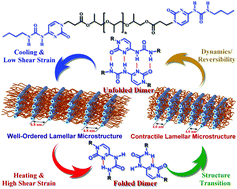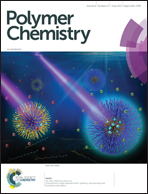Dynamic supramolecular self-assembly: hydrogen bonding-induced contraction and extension of functional polymers†
Abstract
Simple construction and manipulation of low-molecular-weight supramolecular polymers, based on incorporation of self-complementary multiple hydrogen bonding interactions, with the desired dynamic response characteristics to achieve high-efficiency supramolecular assembly and control the morphological properties of the polymers remain highly challenging. Herein, we developed a new difunctional telechelic supramolecular polymer (UrCy-PPG) containing self-complementary quadruple hydrogen-bonded ureido-cytosine (UrCy) moieties, which spontaneously self-assembles to form long-range-ordered lamellar structures in the bulk state. Scattering and rheological studies confirmed that the dynamic behavior of UrCy units induces structural phase transitions from quadruple to dual hydrogen-bonded arrays, leading to well-controlled, self-organized supramolecular nanostructure morphologies. The microstructural features could be easily tuned by altering environmental conditions, making the self-assembly processes highly efficient. Importantly, temperature/shear stress-dependent microstructural analyses indicated that UrCy-PPG has the capacity to manipulate the transition between contractile and fully extended lamellar structures. Given its novelty, simple synthesis, high reliability, and efficient self-assembly processes, this newly developed supramolecular polymer represents a new concept and pathway for controlled arrangement of self-assembled polymeric nanostructures.



 Please wait while we load your content...
Please wait while we load your content...